- Accueil
- Pages cachées
- 22 JUIN 2023 NEWS
22 JUIN 2023 NEWS
INSTITUT SUPERIEUR D'ANTHROPOLOGIE
INSTITUTE OF ANTHROPOLOGY
ONLINE COURSES / COURS A DISTANCE
DEBUT COURS : SEPTEMBRE 2023
REGISTER NOW
TURQUIE –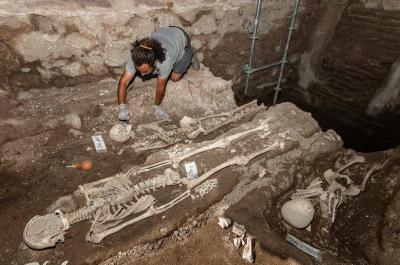 Iznik -A rcheological excavations shedding light on the mysteries surrounding its historic city walls in Bursa's Iznik revealed the presence of numerous burials, demonstrating a longstanding burial tradition in the area 2,300 years ago. Through meticulous archaeological excavations, researchers have made fascinating discoveries in the area between the city walls during the Byzantine and Ottoman periods. Notably, they uncovered the remains of a Roman villa and a building believed to have been built for controlling the fortification gate underneath the city wall. Founded by Antigonius Monophthalmos, one of Alexander the Great's commanders, in 316 B.C., the city of Iznik serves as an extraordinary open-air museum that remarkably preserves the traces of various civilizations such as Bithynia, Roman, Byzantine, Seljuk and Ottoman. The construction of the Iznik Walls, initiated in the fourth century, spans an impressive length of 2.5 kilometers (1.55 miles) and features four main gates, 12 secondary gates and an overall length of 4,970 meters, as recorded by Strabo, an ancient writer. The walls were fortified and extended following attacks by the Goths, a Northern European barbarian tribe, in 258 B.C. Despite enduring sieges and powerful earthquakes throughout history, the historical walls have survived to the present day. Recent archaeological excavations conducted by the Bursa Uludağ University Faculty of Science and Letters Archeology Department in the Yenişehir Gate section of the city walls have unveiled the dual purpose of these formidable structures. Notably, the excavation unearthed numerous skeletons, indicating that the space between the inner and outer walls served as a cemetery during the Eastern Roman and Ottoman eras. Leading the excavation efforts, professor Mustafa Şahin, the head of the Archeology Department, explained the significance of their findings. He stated: "We are conducting these excavations to comprehend and preserve. For instance, we discovered the remains of a building that could be a Roman villa. Oil lamps and similar artifacts dating back to the second century B.C. were found, indicating that the city wall passes directly above the villa. This suggests that some structures were sacrificed during the construction of these fortification walls." Şahin further revealed: "Based on our discoveries, these burials do not belong to Byzantine soldiers who died during attacks or Islamic soldiers who were martyred. They indicate organized burials. We observe the construction of tombs and subsequent burials within them. Among the findings, an intriguing pattern emerges: slightly below ground level, we find tombs belonging to individuals of Christian origin, while just above, there is a tomb indicating Muslim burial practices."
Iznik -A rcheological excavations shedding light on the mysteries surrounding its historic city walls in Bursa's Iznik revealed the presence of numerous burials, demonstrating a longstanding burial tradition in the area 2,300 years ago. Through meticulous archaeological excavations, researchers have made fascinating discoveries in the area between the city walls during the Byzantine and Ottoman periods. Notably, they uncovered the remains of a Roman villa and a building believed to have been built for controlling the fortification gate underneath the city wall. Founded by Antigonius Monophthalmos, one of Alexander the Great's commanders, in 316 B.C., the city of Iznik serves as an extraordinary open-air museum that remarkably preserves the traces of various civilizations such as Bithynia, Roman, Byzantine, Seljuk and Ottoman. The construction of the Iznik Walls, initiated in the fourth century, spans an impressive length of 2.5 kilometers (1.55 miles) and features four main gates, 12 secondary gates and an overall length of 4,970 meters, as recorded by Strabo, an ancient writer. The walls were fortified and extended following attacks by the Goths, a Northern European barbarian tribe, in 258 B.C. Despite enduring sieges and powerful earthquakes throughout history, the historical walls have survived to the present day. Recent archaeological excavations conducted by the Bursa Uludağ University Faculty of Science and Letters Archeology Department in the Yenişehir Gate section of the city walls have unveiled the dual purpose of these formidable structures. Notably, the excavation unearthed numerous skeletons, indicating that the space between the inner and outer walls served as a cemetery during the Eastern Roman and Ottoman eras. Leading the excavation efforts, professor Mustafa Şahin, the head of the Archeology Department, explained the significance of their findings. He stated: "We are conducting these excavations to comprehend and preserve. For instance, we discovered the remains of a building that could be a Roman villa. Oil lamps and similar artifacts dating back to the second century B.C. were found, indicating that the city wall passes directly above the villa. This suggests that some structures were sacrificed during the construction of these fortification walls." Şahin further revealed: "Based on our discoveries, these burials do not belong to Byzantine soldiers who died during attacks or Islamic soldiers who were martyred. They indicate organized burials. We observe the construction of tombs and subsequent burials within them. Among the findings, an intriguing pattern emerges: slightly below ground level, we find tombs belonging to individuals of Christian origin, while just above, there is a tomb indicating Muslim burial practices."
E.A.U. - Al Ain - DCT Abu Dhabi announces several significant archaeological discoveries in the emirate, near the city of Al Ain, revealing artifacts from the Iron Age. The Department of Culture and Tourism – Abu Dhabi (DCT Abu Dhabi) announced several significant archaeological discoveries in the emirate, during “rescue” excavations of a Late Pre-Islamic cemetery found while upgrading roads and infrastructure. In an old Kuwaitat neighborhood that’s part of the “Garden City” Al Ain, the fourth-largest city in the United Arab Emirates and second-largest in the Abu Dhabi emirate, the excavation site revealed artifacts from the Iron Age up to the Pre-Islamic period (1300 BCE to 600 CE). DCT Abu Dhabi reported that around twenty individual graves were found, as well as some “exceptionally well-preserved” objects, including intact amphorae and other ceramics, bronze bowls and other glass and alabaster vessels. Additionally, it uncovered “substantial quantities” of iron weapons, including arrows, spears, and a number of swords. The government officials stated that “the existence of a cemetery suggests a settlement of the same period was probably located nearby, and the presence of deep underground-water channels (aflaj) noted in this area provides further evidence for the creation of the nearby Al Ain Oasis in this period.”
ANGLETERRE –  Ipswich - This new experimental archaeology project is being led by Suffolk County Council Archaeological Service, to investigate how Anglo-Saxon pottery was once made in Ipswich. The new kiln has been built and fired by studying archaeological remains excavated from the Buttermarket in Ipswich, something never attempted before. Only two kilns have ever been excavated in Ipswich, the other was discovered at Stoke Quay. Ipswich ware pottery was made in the town from c. AD 680-870. Jars, cooking pots and pitchers were the most commonly-made items, simple in design and grey in colour. They were mass-produced and distributed throughout eastern England, and were some of the first of their kind in post-Roman Britain.
Ipswich - This new experimental archaeology project is being led by Suffolk County Council Archaeological Service, to investigate how Anglo-Saxon pottery was once made in Ipswich. The new kiln has been built and fired by studying archaeological remains excavated from the Buttermarket in Ipswich, something never attempted before. Only two kilns have ever been excavated in Ipswich, the other was discovered at Stoke Quay. Ipswich ware pottery was made in the town from c. AD 680-870. Jars, cooking pots and pitchers were the most commonly-made items, simple in design and grey in colour. They were mass-produced and distributed throughout eastern England, and were some of the first of their kind in post-Roman Britain.
ESPAGNE – 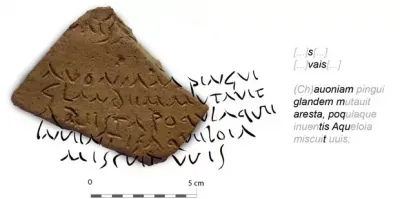 Hornachuelos - A tiny fragment of a Roman jar that once held olive oil, produced in what is now southern Spain, has left archaeologists delighted, puzzled and “saucer-eyed” after they deciphered a quote from the ancient poet Virgil that was cut into its clay by an unknown but erudite hand 1,800 years ago. While the ceramic vessels were routinely engraved with information relating to producers, quantities and taxes, the 6cm by 8cm shard appeared to contain an unusual amount of text. Subsequent examinations by Latin experts determined that the fragment bore a quote from Virgil, best known as the author of the epic Latin poem the Aeneid. As far as González Tobar and his colleagues are aware, the fragment is the first time that a line from literature has turned up on a clay vessel.“There are quite a lot of bricks that have been found with texts from Virgil on them because we think they’d been used for teaching before being used for building,” said González Tobar. “But nothing’s been found on amphorae.”Given the fragment was found in a rural area where much of the olive oil sent to Rome was produced and bottled, the team thinks Virgil’s agriculturally themed Georgics may have struck the engraver as more fitting that the heroics of the Aeneid. The researchers’ key theory, as published in the Journal of Roman Archeology, is that the verses, written on the lower part of the amphora, were never really intended to be seen. They believe the author may have been a skilled labourer or perhaps even a child worker at the factory where the amphora was manufactured. In any case, the lines make it clear that whoever scratched the letters into the clay was more educated than such workers are traditionally supposed to have been.
Hornachuelos - A tiny fragment of a Roman jar that once held olive oil, produced in what is now southern Spain, has left archaeologists delighted, puzzled and “saucer-eyed” after they deciphered a quote from the ancient poet Virgil that was cut into its clay by an unknown but erudite hand 1,800 years ago. While the ceramic vessels were routinely engraved with information relating to producers, quantities and taxes, the 6cm by 8cm shard appeared to contain an unusual amount of text. Subsequent examinations by Latin experts determined that the fragment bore a quote from Virgil, best known as the author of the epic Latin poem the Aeneid. As far as González Tobar and his colleagues are aware, the fragment is the first time that a line from literature has turned up on a clay vessel.“There are quite a lot of bricks that have been found with texts from Virgil on them because we think they’d been used for teaching before being used for building,” said González Tobar. “But nothing’s been found on amphorae.”Given the fragment was found in a rural area where much of the olive oil sent to Rome was produced and bottled, the team thinks Virgil’s agriculturally themed Georgics may have struck the engraver as more fitting that the heroics of the Aeneid. The researchers’ key theory, as published in the Journal of Roman Archeology, is that the verses, written on the lower part of the amphora, were never really intended to be seen. They believe the author may have been a skilled labourer or perhaps even a child worker at the factory where the amphora was manufactured. In any case, the lines make it clear that whoever scratched the letters into the clay was more educated than such workers are traditionally supposed to have been.
PAYS-BAS – 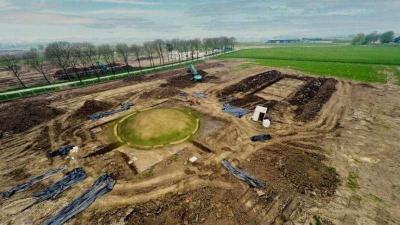 Tiel - Archaeologists have discovered a 4,000-year-old sanctuary made up of ditches and burial mounds in the central Netherlands that they believe may have served a similar purpose to Stonehenge.Like the famous stone circle in southern England, the sanctuary - which was as big as at least three soccer fields and built with soil and wood - was built to align with the sun on the solstices.The archaeologists also discovered offerings, including animal skeletons, human skulls and valuable items such as a bronze spearhead, at the spots where the sun shone through the openings, according to a statement from the municipality of Tiel, a town around 70 km (45 miles) east of Rotterdam where the site was excavated.While excavating the site in 2017, archaeologists also discovered several graves. One grave was of a woman buried with a glass bead from Mesopotamia, present-day Iraq. It's the oldest bead ever found in the Netherlands and researchers said it proved people of this area were in contact with people almost 5,000 km away.The archaeologists took six years to research more than a million excavated objects dating from the Stone Age, the Bronze Age, the Iron Age, the Roman Empire and the Middle Ages.
Tiel - Archaeologists have discovered a 4,000-year-old sanctuary made up of ditches and burial mounds in the central Netherlands that they believe may have served a similar purpose to Stonehenge.Like the famous stone circle in southern England, the sanctuary - which was as big as at least three soccer fields and built with soil and wood - was built to align with the sun on the solstices.The archaeologists also discovered offerings, including animal skeletons, human skulls and valuable items such as a bronze spearhead, at the spots where the sun shone through the openings, according to a statement from the municipality of Tiel, a town around 70 km (45 miles) east of Rotterdam where the site was excavated.While excavating the site in 2017, archaeologists also discovered several graves. One grave was of a woman buried with a glass bead from Mesopotamia, present-day Iraq. It's the oldest bead ever found in the Netherlands and researchers said it proved people of this area were in contact with people almost 5,000 km away.The archaeologists took six years to research more than a million excavated objects dating from the Stone Age, the Bronze Age, the Iron Age, the Roman Empire and the Middle Ages.
VIDEO = https://www.jpost.com/archaeology/article-747101
NORVEGE – 
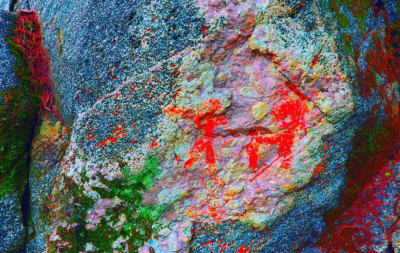 Østfold - The discovery was made by Tormod Fjeld who noticed mysterious shades of colour in a rockface where he and his family had stopped for a rest break. Using an app on his phone, Fjeld was able to highlight the different colour shades by applying various filters, revealing images of a boat with rowers, an animal, and several human figures. Østfold is among Norway’s oldest inhabited regions, with petroglyphs, pictographs, and burial mounds being documented throughout the area. The team from NIKU confirmed the discovery which has been dated to Norway’s Bronze Age, with Professor Jan Magne Gjerde from NIKU stating that the discovery is one of the earliest rock art sites in this part of the country. The Bronze Age in Scandinavia is said to begin shortly after 2000 BC with the introduction and use of bronze tools, followed by a more systematic adoption of bronze metalworking technology from 1750 BC. Due to the historical importance, the exact location is being kept confidential, with NIKU only stating that the site is in the Moss municipality. This is because the pigments used for the pictographs are easily damaged, with even human touch being enough to cause irreparable damage.
Østfold - The discovery was made by Tormod Fjeld who noticed mysterious shades of colour in a rockface where he and his family had stopped for a rest break. Using an app on his phone, Fjeld was able to highlight the different colour shades by applying various filters, revealing images of a boat with rowers, an animal, and several human figures. Østfold is among Norway’s oldest inhabited regions, with petroglyphs, pictographs, and burial mounds being documented throughout the area. The team from NIKU confirmed the discovery which has been dated to Norway’s Bronze Age, with Professor Jan Magne Gjerde from NIKU stating that the discovery is one of the earliest rock art sites in this part of the country. The Bronze Age in Scandinavia is said to begin shortly after 2000 BC with the introduction and use of bronze tools, followed by a more systematic adoption of bronze metalworking technology from 1750 BC. Due to the historical importance, the exact location is being kept confidential, with NIKU only stating that the site is in the Moss municipality. This is because the pigments used for the pictographs are easily damaged, with even human touch being enough to cause irreparable damage.
https://www.heritagedaily.com/2023/06/hiker-finds-bronze-age-pictographs-in-norway/147707
SUEDE –  Bohuslän’ - Two millennia or so ago, sailing ships, grazing animals, and people—hunting, gathering, dancing—were carved into cave walls, then obscured, slowly, by layers of moss. Ultimately, they were lost to time. Or lost until last month, when a team of researchers surveying the western Swedish province of Bohuslän uncovered the ancient artwork. The carvings, or petroglyphs, were made around 2,700 years ago, according to the Foundation for Documentation of Bohuslän’s Rock Carvings. They measure around three-meters high and decorate a steep rock face that once formed the edge of an island before sea levels dropped around 40 feet over several centuries. The team has since speculated that the artists reached the rock by boat, or constructed a sort of scaffolding over ice. (The researchers used scaffolding themselves to inspect the artworks.) The deep carvings were made by striking stones against the granite rock to reveal a brilliant white underlayer that would have been visible for several miles.“What makes the petroglyphs completely unique is that they are located three meters above today’s ground surface,” the foundation wrote in a statement. “The motifs lie on an even line that follows the height of the sea surface from approximately 700 to 800 BCE. The motifs are also stylistically consistent with this time period.”
Bohuslän’ - Two millennia or so ago, sailing ships, grazing animals, and people—hunting, gathering, dancing—were carved into cave walls, then obscured, slowly, by layers of moss. Ultimately, they were lost to time. Or lost until last month, when a team of researchers surveying the western Swedish province of Bohuslän uncovered the ancient artwork. The carvings, or petroglyphs, were made around 2,700 years ago, according to the Foundation for Documentation of Bohuslän’s Rock Carvings. They measure around three-meters high and decorate a steep rock face that once formed the edge of an island before sea levels dropped around 40 feet over several centuries. The team has since speculated that the artists reached the rock by boat, or constructed a sort of scaffolding over ice. (The researchers used scaffolding themselves to inspect the artworks.) The deep carvings were made by striking stones against the granite rock to reveal a brilliant white underlayer that would have been visible for several miles.“What makes the petroglyphs completely unique is that they are located three meters above today’s ground surface,” the foundation wrote in a statement. “The motifs lie on an even line that follows the height of the sea surface from approximately 700 to 800 BCE. The motifs are also stylistically consistent with this time period.”
MEXIQUE –  Conhuas - The discovery was made during construction works of Section 7 of the Maya Train near the village of Conhuas in the Mexican state of Campeche. Conhuas is situated in close proximity to the ruins of Balamku, a Maya temple complex which contains one of the largest surviving stucco friezes from the Maya world. The statue is sculptured from limestone and may depict Cizin, also spelled Kisin, the Maya god of death, whose name is believed to mean “Stinking One.” According to Lacandon myth, when a person dies, Cizin burns the soul on his mouth and his anus until the soul disintegrates into nothing. The statue measures 25 centimetres in height and shows the deity with an erect tabular cranial modification in a seated position wearing a nose ring and mask. “It is a figure with stark features that appeals to mortuary motifs and would be linked to a deity of death,” said the head of the INAH. Excavations of Section 7 on the Maya Train project, a 1,525-kilometre intercity railway that will traverse the Yucatán Peninsula, have also revealed 21,960 immovable sites that will be protected, in addition to 72,480 ceramic potsherds, 64 human burials, and 227 natural features associated with human occupation.
Conhuas - The discovery was made during construction works of Section 7 of the Maya Train near the village of Conhuas in the Mexican state of Campeche. Conhuas is situated in close proximity to the ruins of Balamku, a Maya temple complex which contains one of the largest surviving stucco friezes from the Maya world. The statue is sculptured from limestone and may depict Cizin, also spelled Kisin, the Maya god of death, whose name is believed to mean “Stinking One.” According to Lacandon myth, when a person dies, Cizin burns the soul on his mouth and his anus until the soul disintegrates into nothing. The statue measures 25 centimetres in height and shows the deity with an erect tabular cranial modification in a seated position wearing a nose ring and mask. “It is a figure with stark features that appeals to mortuary motifs and would be linked to a deity of death,” said the head of the INAH. Excavations of Section 7 on the Maya Train project, a 1,525-kilometre intercity railway that will traverse the Yucatán Peninsula, have also revealed 21,960 immovable sites that will be protected, in addition to 72,480 ceramic potsherds, 64 human burials, and 227 natural features associated with human occupation.
ISRAEL – 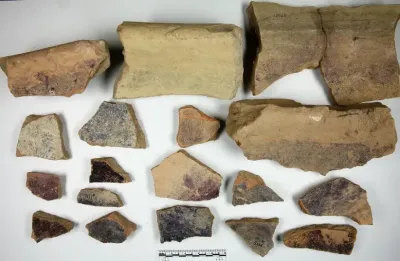 Shikmona - Tel Shikmona, which was under the control of the Kingdom of Israel between the middle of the ninth century and the middle of the eighth century BCE, was the largest purple factory in the area during the Iron Age and the one that apparently supplied the prestigious purple color to the First Temple. A new study by the University of Haifa claims to completely change the story of the biblical Shikmona and turn it into one of the most fascinating testimonies to the flourishing of the Kingdom of Israel and its extensive conquests in the north of the country at that time.Tel Shikmona is an ancient Phoenician archaeological mound situated near Haifa. The Mishna, compiled in 189 CE, mentions Shikmona as being renowned for its cultivated variety of jujube trees, which produced a gummy type of candy drop. According to the new research, Tel Shikmona was a large factory for the production of purple under Israelite control – the only of its kind in the entire Levant discovered so far – which provided the prestigious and rare purple color to the kingdoms of the region and apparently also to the weaving of the sanctuary curtain of the Temple.“The Tel Shikmona factory supplied purple products, mainly purple-dyed thread, to Cyprus and Lebanon and also to socio-political elites and temples in the cities of Judea, and of course to rich residents of the Kingdom of Israel.
Shikmona - Tel Shikmona, which was under the control of the Kingdom of Israel between the middle of the ninth century and the middle of the eighth century BCE, was the largest purple factory in the area during the Iron Age and the one that apparently supplied the prestigious purple color to the First Temple. A new study by the University of Haifa claims to completely change the story of the biblical Shikmona and turn it into one of the most fascinating testimonies to the flourishing of the Kingdom of Israel and its extensive conquests in the north of the country at that time.Tel Shikmona is an ancient Phoenician archaeological mound situated near Haifa. The Mishna, compiled in 189 CE, mentions Shikmona as being renowned for its cultivated variety of jujube trees, which produced a gummy type of candy drop. According to the new research, Tel Shikmona was a large factory for the production of purple under Israelite control – the only of its kind in the entire Levant discovered so far – which provided the prestigious and rare purple color to the kingdoms of the region and apparently also to the weaving of the sanctuary curtain of the Temple.“The Tel Shikmona factory supplied purple products, mainly purple-dyed thread, to Cyprus and Lebanon and also to socio-political elites and temples in the cities of Judea, and of course to rich residents of the Kingdom of Israel.
https://www.jpost.com/archaeology/article-746977
CHINE – 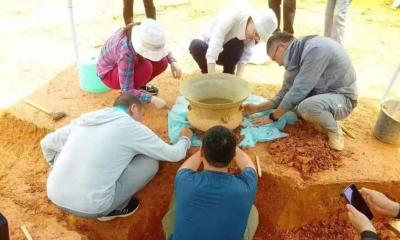 Pingguo - An ancient tomb that belongs to the Warring States Period (475BC-221BC) has recently been discovered in Pingguo, a city in South China's Guangxi Zhuang Autonomous Region. The burial includes precious artifacts such as a jade ring and a jade jue - an ancient earring-like decoration - and several other bronze relics have been discovered, with a bronze drum considered to be the ancient tomb's stellar discovery. The bronze drum was identified by local archaeologists as belonging to earlier than the Warring States Period and it is styled in the particular form of "Shizhai Shan." A piece of bronze spear and a thousand years old yue were unearthed together with the Shizhai Shan drum. The bronze yue was often used as an axe by ancient Chinese people. Aside from the tomb, the excavation team has also found a 10-meter by 10-meter square pit. Neolithic stone tools and porcelain fragments were collected from the pit.
Pingguo - An ancient tomb that belongs to the Warring States Period (475BC-221BC) has recently been discovered in Pingguo, a city in South China's Guangxi Zhuang Autonomous Region. The burial includes precious artifacts such as a jade ring and a jade jue - an ancient earring-like decoration - and several other bronze relics have been discovered, with a bronze drum considered to be the ancient tomb's stellar discovery. The bronze drum was identified by local archaeologists as belonging to earlier than the Warring States Period and it is styled in the particular form of "Shizhai Shan." A piece of bronze spear and a thousand years old yue were unearthed together with the Shizhai Shan drum. The bronze yue was often used as an axe by ancient Chinese people. Aside from the tomb, the excavation team has also found a 10-meter by 10-meter square pit. Neolithic stone tools and porcelain fragments were collected from the pit.
https://www.globaltimes.cn/page/202306/1292963.shtml
NORVEGE – 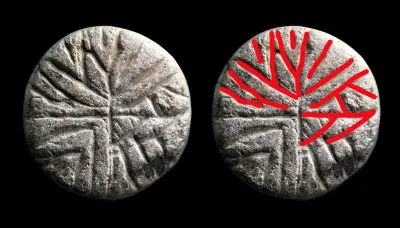 Trondheim - The area that was excavated was a mere four metres long, but it turned out to be very deep. At 3,8 metres under today’s surface, the archaeologists found birch bark dated to around 1000-1150 AD. Slightly higher up they found a layer of coal dated to around 1030-1180 AD. The gaming piece in soapstone was found between these two layers. “Ever since I studied runology I’ve wanted to find a runic inscription, so this was a dream find,” archaeologist Dag-Øyvind Solem says in a press release from the Norwegian Institute for Cultural Heritage Research (NIKU). The find is unusual for Trondheim, where only two items with runic inscriptions have been found previously.Runologist Karen Langsholt Holmqvist, associate professor at NLA University College in Oslo, confirmed that the gaming piece was in fact inscribed with runes. Holmqvist has previously studied runes in Norway and Scotland, and wrote her PhD thesis on what old graffiti can tell us about medieval people. “When you first look at the gaming piece, it may look as though it simply has an uneven geometric pattern, perhaps a snow crystal. But when I examined the piece closer I could see that the lines were not random patterns, but meticulously planned runic inscriptions,” Holmqvist says in the press release. “The inscription follows the curve of the gaming piece, and so it is a bit odd, but there is no doubt that these are runes,” she says. Examining the piece in a microscope, Holmqvist also discovered that whoever made these inscriptions had first scratched helping lines, suggesting that the inscription was well planned in order to follow the shape of the round gaming piece. In areas of the piece where there are no runes, the inscriber has created a decorative pattern.
Trondheim - The area that was excavated was a mere four metres long, but it turned out to be very deep. At 3,8 metres under today’s surface, the archaeologists found birch bark dated to around 1000-1150 AD. Slightly higher up they found a layer of coal dated to around 1030-1180 AD. The gaming piece in soapstone was found between these two layers. “Ever since I studied runology I’ve wanted to find a runic inscription, so this was a dream find,” archaeologist Dag-Øyvind Solem says in a press release from the Norwegian Institute for Cultural Heritage Research (NIKU). The find is unusual for Trondheim, where only two items with runic inscriptions have been found previously.Runologist Karen Langsholt Holmqvist, associate professor at NLA University College in Oslo, confirmed that the gaming piece was in fact inscribed with runes. Holmqvist has previously studied runes in Norway and Scotland, and wrote her PhD thesis on what old graffiti can tell us about medieval people. “When you first look at the gaming piece, it may look as though it simply has an uneven geometric pattern, perhaps a snow crystal. But when I examined the piece closer I could see that the lines were not random patterns, but meticulously planned runic inscriptions,” Holmqvist says in the press release. “The inscription follows the curve of the gaming piece, and so it is a bit odd, but there is no doubt that these are runes,” she says. Examining the piece in a microscope, Holmqvist also discovered that whoever made these inscriptions had first scratched helping lines, suggesting that the inscription was well planned in order to follow the shape of the round gaming piece. In areas of the piece where there are no runes, the inscriber has created a decorative pattern.



